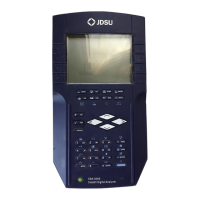Measuring System Performance: Carrier-to-Noise Measurements
119
6
The Limit feature allows for comparison of the current scan measurement
with the FCC or other conformance/test limits defined during setup and
configuration. There are two parts to this feature:
• When an out-of-tolerance condition exists, a set of annunciators will
appear below the graph. Updated with each scan update, the
annunciators indicate the following out of tolerance conditions:
<CHAN> Adjacent Channel Error
VIDEO ∨ Video Level Too High or Low
DVA ∧ Delta between video and audio too high or low
• You can display an aggregate result summary by pressing the Limit soft
key. This performs a limit check of all channels contained within the
scan, and reports an overall pass/fail conclusion. The aggregate limit
check is not performed with each scan update; however, you can press
the Check soft key to run the test any time. When Limit is off, the
annunciators do not appear.
• When scanning a digital channel, digital signal limits are checked against
the limits you set in the channel plan.
Although it’s not necessary, it is good CATV engineering practice to use a
band pass filter on the input of the SDA-5000 when making C/N
measurements. This ensures accuracy and extends measurement range. If
a preamplifier is used to boost test point levels prior to measurement, it
should be placed between the band pass filter and the SDA unit.
The C/N measurement is simply a comparison in amplitude between the
video carrier reference signal and the noise (FCC limit: > 43 dB). The noise
measurement should be made at a frequency offset (displacement from the
video center frequency) of least 2 to 2.5 MHz from any other carrier on the
system.
The C/N measurement mode displays the carrier-to-noise ratio of the tuned
channel or frequency. You can set C/N measurement bandwidth and the
frequency offset for the noise measurement from the screen. A proprietary
DSP technique allows C/N measurements, in-service, on modulated carriers
(non-scrambled channels). The C/N measurement measures the video
carrier level and then tune to the offset frequency, searching for a quiet line.
After a quiet line is found, the SDA-5000 measures four consecutive frames,
CARRIER-TO-NOISE MEASUREMENTS

